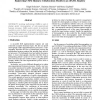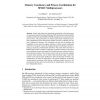98 search results - page 9 / 20 » Defining Adaptation Constraints for Business Process Variant... |
CAISE
2011
Springer
12 years 11 months ago
2011
Springer
Abstract. Flexibility and automatic learning are key aspects to support users in dynamic business environments such as value chains across SMEs or when organizing a large event. Pr...
WECWIS
2006
IEEE
14 years 1 months ago
2006
IEEE
UN/CEFACT’s modeling methodology (UMM) is used to develop global choreographies of inter-organizational business processes. UMM models should be publically available in order to...
CAISE
2006
Springer
13 years 11 months ago
2006
Springer
Information system models commonly describe organizations in terms of the structure of the data they use, the organization of the processes they perform and the operations that wil...
HIPC
2000
Springer
13 years 11 months ago
2000
Springer
Abstract. Simple and unified non-operational specifications of the three memory consistency models Total Store Ordering (TSO), Partial Store Ordering (PSO), and Relaxed Memory Orde...
SPLC
2010
13 years 5 months ago
2010
Product line engineering allows for the rapid development of variants of a domain specific application by using a common set of reusable assets often known as core assets. Variabil...


